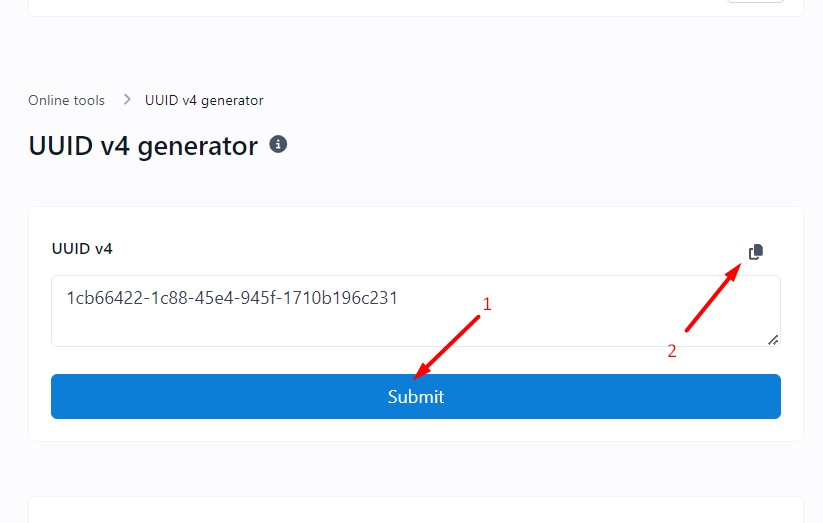UUID v4 Generator
About the UUID v4 Generator Tool
The free Nerd Tools online UUID generator tool is an online tool that allows you to generate v4 UUIDs. Using a secure random number generator, this tool produces UUIDs of Version 4.. This page automatically creates a UUID when you access it. Using the tool is entirely free and does not require registration.
What is Version 4 UUID?
Universally unique identifiers (UUIDs) are 128-bit numbers used in computers to identify data. In Version 4, UUIDs are generated using random numbers based on universally unique identifiers. Because these are generated randomly, duplication is possible but unlikely. Since each Version 4 UUID contains a random bit, you would need to generate trillions of them before you would receive the same set.
A Version 4 UUID enables you to:
- Produce UUIDs that are simpler and do not reveal the source
- Find matches faster when comparing long lists of information with UUIDs
What is UUID Used For?
This UUID is a 128-bit value used on the internet to identify objects and entities uniquely. Any data can be identified with a UUID. Databases, system instances, primary keys, Bluetooth profiles, and others can be identified using them.
How to Use Our Tool
We have developed a UUID Generator tool to help you generate UUID online. This tool is easy to use. Here's how:
- Open the generator by visiting the page.
- Please click on "Submit" to generate a new v4 UUID.
- It will create a UUID Version 4 as a result.
- If you click the copy icon, the unique identifier that is generated will be copied to your clipboard.
- To use the UUID, paste it where needed.

Repeat the above steps if you want to generate a new UUID.
UUID Versions and Their Difference
UUIDs are available in the following versions:
Version 1:
The unique host identifier of this version is derived from a specified time and node(mac address of the computer).
For example, version 1 UUID is d391b480-65de-11ed-bc6e-7f7234ef9f96.
Version 2:
Version 2 is mainly similar to version 1. However, a few less significant bits are changed. The clock sequence with eight bits associated is replaced with a local domain number, and the timestamp with 32 bits is associated with the local domain number mentioned in the clock sequence. This type of UUID is reserved for DCE Security UUIDs.
Version 3:
The namespace identifier and the name are hashed together to generate this version. The hashing algorithms for versions 3 and 5 are similar, except that version 3 uses message-digest algorithm 5 (MD5).
For example, for the namespace 'dee25820-65df-11ed-a5cf-b33993b39953' and name 'Free Nerd' the v3 UUID is 0ab55d47-791a-321a-b855-337024a6c1ea. The same combination of namespace and name will always generate the same v3 UUID.
Version 4:
UUIDs are generated randomly in this version. Even though the random UUID uses random bytes, version 4 is indicated by four bits, while the variant is characterized by two to three bits. The number of UUID combinations is reduced in this version because more bits are used. The number of UUID combinations is still sufficient to prevent collisions.
For example, version 4 UUID is
ac59736e-01f6-4e8e-847f-d9fb7dc37923
Version 5:
It is the same method as version 3 that generates version 5. Secure Hash Algorithm 1, or SHA-1, is used for hashing instead of MD5, which is used for version 3. To identify information and data within a system's namespace, versions 3 and 5 are well suited.
For instance, UUID v5 for namespace “1dd3e767-1bb4-4678-a4ee-7280861837ff” and name ‘Free Nerd’ is 903fb068-3452-59f5-abc2-e2682c0d8bfe
GUID vs. UUID
UUID (Universally Unique Identifier) and GUID (Global Unique Identifier) are two separate ways of implementing the same concept. A GUID or UUID identifies a unique object or record. A big data environment is ubiquitous for these, where coordinating unique IDs is difficult. It is not essential to distinguish between GUID and UUID when it comes to practical considerations and in nearly all use cases. There are times when GUID refers to the Microsoft implementation of UUID. Strictly speaking, a UUID is unique worldwide (universal scope), but a GUID is unique only globally (global scope). There is no multiversal uniqueness, so neither can be referred to as a MUID. Generally, you should avoid using GUIDs on interplanetary levels. Apart from that, both can be used interchangeably.
UUID vs. ULID
A UUID is a unique identifier whose format and generation are standardized. A valid UUID is defined by RFC 4122, the specification used to define them. By using UUIDs, you ensure your IDs are unique at the global level rather than just within a single application or database table.
Meanwhile, Universally Unique Lexicographically Sortable IDentifiers, or ULIDs, are 28-character strings of sixteen random characters with millisecond precision and ten timestamp characters. It consists of both 48-bit and 80-bit base32 encoded strings. A ULID relies on both timestamps and randomness to ensure its uniqueness, while UUIDs depend solely on timestamps.
NanoID vs. UUID
UUIDs are among the most commonly used universal identifiers in today's world. Using Nanoid, you can create unique IDs that are secure, URL-friendly, and easy to use.
NanoID's usage has dramatically increased in comparison with UUID in recent years. NanoID is frequently preferred over UUID because of its small size and 60% faster speed. Due to Nano ID's larger alphabet, there are 21 symbols instead of 36, allowing the same number of random bits to be packed into 21 symbols.